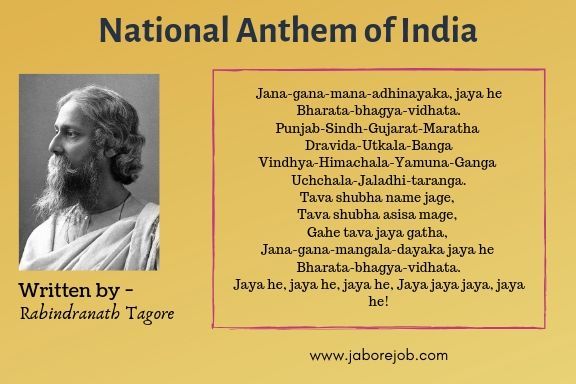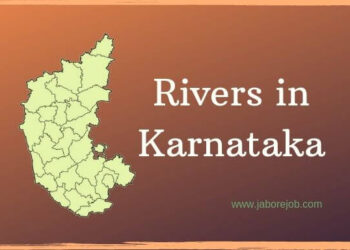The National Symbols of India represents the image of the country and have been chosen carefully representing the history, culture, tradition, climate, people, nature, pride, etc. Here in Jaborejob.com, we provided the information on the National Symbols of India with pride, also containing topics of your interest, in the future as well.
The National Animal symbolizes power, National Flower symbolizes purity, National Tree symbolizes immortality, National Bird symbolizes elegance, National Fruit symbolizes the tropical climate of the country, National Song & National anthem symbolizes the source of inspiration for the struggle for freedom, National Emblem of India symbolizing power, courage, pride, and confidence, etc…
Here is the 18 Must-Know National Symbols of India, you may be knowing but we provided in-depth information.
List of 18 National Symbols of India
1) National Anthem – Jana Gana Mana

Every country will have its own National Anthem which is sung on special events like, school day, or before starting sports, national day, inaugurations, etc. The National Anthem of India, “Jana Gana Mana”, was written in the Bengali language by Nobel Prize winner Rabindranath Tagore in 1911. It was the first time that it was sung at the Calcutta Congress session on December 27, 1911.
The song Jana Gana Mana was published for the first time with the title “Bharat Vidhata” in Tattva Bodhini Patrika in January 1912. Later, the song was translated from the Bengali language to the English language in 1919 under the title “Morning Song of India”. The song was adopted as National Anthem on 24th January 1950 in the Hindi language. It takes the total completion of about 52 seconds, in the shortest version with the first and last lines of the stanza take 20 seconds to sing.
The song shows the national heritage of India and shows patriotism, pride, and national loyalty. It acts as a catalyst for the feeling of national pride. An interesting fact to be noticed initially that the original Bengali poem was containing only the provinces mentioned under British rule were mentioned, namely, Punjab, Sind, Gujarat, Maratha, etc.
These princely states (Kashmir, Rajasthan, Andhra, Mysore, or Kerala) that were ruled by the Portuguese were not mentioned in the anthem. The Anthem speaks the differences in culture, beliefs, caste and religion, and the feeling of unity that reigns in each Indian.
2) National Animal – Bengal Tiger
The Bengal tiger was declared as a National Animal of India in April 1973, with the launching of the ‘Project Tiger’, designed to protect tigers in India. Till the date, 27 tiger reserves have been established in the country under this project, covering an area of 37,761 km2.
Before that, the lion was the national animal of India. As a national animal of India, the tiger symbolizes the richness of Indian wildlife. There are approx 2,500 tigers in our country and statistics are increasing due to the praiseworthy efforts of the government of India.
You can find Bengal Tiger mainly in India and few parts of Nepal, Bhutan, China, Bangladesh, and Myanmar. In India, you cannot hunt the National Animal Tiger for any purpose, or else you will be punished under the law.
To give a place of honor to a national animal, the Bengal Tiger images have been placed on Indian Currency, as well as on Postage Stamps. The scientific name of the Bengal tiger is Panthera Tigris and is the big 4 leg cats of the genus Panthera (lion, tiger, jaguar, and leopard).
3) National Tree – Banyan Tree
The Indian Banyan Tree is the National Tree of India and symbolizes immortality. The roots of trees spread over a large area for a period of time. It represents longevity and is also part of Hindu mythology. It has huge branches, strong trunks, and deep roots, it has a longer life than any other tree on the earth. You can see these type of trees near temples and is used for shelter.
It also has tremendous medicinal value and is beneficial for the treatment of many diseases. In Sanskrit, it is also called Kalpavriksha and, according to ancient accounts, it is considered a divine tree capable of fulfilling desires. It also serves as a meeting point for meetings and panchayats in the villages throughout the country.
Saalumarada Thimmakka is famous for planting 380 Banyan Trees along a 4Km highway between Hulikal and Kudur in Karnataka, she cared trees like her children throughout her life by providing water and nutrition. Another place Kabirvad is a small island on the Narmada River near Vadodara (Gujarat) and is popular for the gigantic Banyan tree that covers an area of 3.7 acres.
In Theravada Buddhism, it is said that this tree was used as a tree to attain enlightenment, or Bodhi, by the 24th Buddha called “Kassapa – කස්සප”. In India, the Great Banyan in the Chandra Bose Botanical Garden of Jibadish in Shibpur, Howrah, whose canopy measures 18,918 square meters (203,630 square feet) and approximately 250 years of age.
Dodda Alada Mara in Kettohalli, Karnataka, which has an area of 12,000 square meters (130,000 square feet) and is approximately 400 years old and it is the 4th biggest Banyan Tree in the world.
4) National Song – Vande Mataram
The Indian National Song was composed in the Sanskrit language by poet Bankimchandra Chatterjee in 1870. He included this song in the novel Anandamath in 1882. He inspired many freedom fighters in the struggle for freedom. The poem was composed in a song by Rabindranath Tagore.
The first two verses of the song were adopted as the national song of India in October 1937 by the Congress Working Committee before the end of the colonial government in August 1947. It was adopted as the national song of India by the National Assembly of India on 24th January 1950, and the meaning of 3 popular words is “I praise thee, mother”.
Originally, Vande Mataram (also pronounced as Bande Mataram) was the national anthem of India, but after independence, Jana Gana Mana was adopted as a national anthem. This was done because the non-Hindu communities in India had considered Vande Mataram partial. These communities felt that the nation was represented by “Maa Durga” in the song. That’s why it became the national song of India and not the national anthem.
The National Song “Vande Mataram” was the only slogan of the entire nation for independence [against the British government] during the freedom movement. The large gatherings, originally fermented in Bengal, in the great metropolis of Calcutta, would become patriotic fervor by shouting the slogan “Vande Mataram”.
The British, feared the potential danger of an Indian-induced population, banned the book, and recited the song as a crime.
5) National Flag – Tiranga
A Tricolor Flag is the National Flag of India, the rectangle silk cloth is divided horizontally with 3 parts, it contains Saffron color at the top represents strength and courage of the country, White color in the center represents peace and truth, and Green color at the bottom represents fertility, growth, and auspiciousness of the land. In the center, it has a 24-spoke navy blue wheel called “Ashoka Chakra”.
The flag represents Swaraj or freedom designed by Pingali Venkayya. The national flag of India was adopted in its current form at the meeting of the Constituent Assembly on 22nd July 1947, a few days before India’s independence from the British, on 15th August 1947.
In accordance with the provisions of the Flag Code of India of 2002, members of the general public, private organizations, educational institutions, etc. They are not subject to any restriction on the display of the national flag, except as provided in the Emblems and Names (Prevention) Act of 1950 on the prevention of insults to the national honor and any law enacted in this regard.
The first unofficial flag raised by the Indians appeared on August 7, 1906, in Parsee Bagan, Calcutta. The rectangular flag consisted of 3 horizontal stripes of green, yellow, and red from top to bottom. The highest green segment contained 8 lotuses representing 8 provinces, the middle yellow segment had the words Band Mataram in Sanskrit and the lower red band had a crescent on the left and sun on the right.
6) National Bird – Peacock
The Indian peacock was adopted as the National Bird of India. A bird native to the subcontinent, the peacock represents the unity of bright colors and finds references in Indian culture. Another reason why the peacock is chosen as a national bird is due to its widespread presence throughout the country, so much so that even the common people know it well.
On 1st February 1963, the government of India decided to make the peacock as the national bird of India. The decision was taken after considering the opinions of state governments and the opinions expressed in the press.
The issue of choosing a national bird has been under consideration since the Tokyo Conference of the International Council for Bird Conservation, held in May 1960. This issue has been discussed by the Indian Wildlife and Wildlife Council. State governments were also invited to give their point of view… Other birds considered for this honor include the great Indian bustard, the Sarus crane, the “Garuda”, and the swan (Hamsa), the strong competitor was great Indian bustard.
The male species is more colorful than the female peacock, with a bright blue chest and neck and a spectacular bronze-green tail of approximately 200 elongated feathers. The female is brown, slightly smaller than the male, and has no tail. The elaborate dance of the parade of the male, unfolding its tail and opening its feathers, is a magnificent view.
The Indian peacock has benefited from special conservation efforts due to its status as the National Bird of India. The hunting of these birds is illegal. Although the total number of Indian Peafowl is unknown, they are abundant enough to be labeled as “Minor Concern” by the IUCN Red List.
7) National Flower – Lotus
The beautiful and aromatic flower Lotus is the National Flower of India. It symbolizes light, purity, and wealth. Even though the flower grows in dirty water it remains pure, therefore used to praise God mainly for goddess Lakshmi.
At night after the sunset, it closes its petals and sinks deep into the water, it raises with shine in the morning after the sunrise. The Lotus originates in East Asia, although its distribution is global in semi-tropical climatic conditions. It is predominant in the Indian subcontinent, particularly in India, Bangladesh, and Myanmar.
In addition to its cultural importance, the seeds of the national flower are medicinal and are used in the treatment of the spleen, heart diseases, and kidneys. Lotus seeds are edible. The leaf and the peduncle are eaten as a vegetable in India.
The lotus tubers taste like sweet potatoes. Its petals are used to decorate and the large leaves are used to wrap the leaves. Its seeds called Phool Mukhana are used in Indian cuisine. The recent controversy on 9th July 2019, the government has not accepted the status of any flower as National Flower of India, said by Minister of State for Home Nityananda Rai in Rajya Sabha.
8) National Fruit – Mango
Who doesn’t love Mangoes tell me, the delicious Mango is the king of fruits and also adopted as the National Fruit of India. It is originated in India with a wide variety of tastes, and colors. India produces 43% of the total mango crop in the world. It has health benefits, it contains a high volume of Vitamin A, C, and D.
The importance of mango should be emphasized at the International Mango Festival in Delhi, where different varieties of mangoes are brought into one place. Mangoes have a rich source of antioxidants that helps to fight certain types of cancer.
In addition, having fiber, vitamins, etc. It strengthens the immune system and decreases the suffering of people from various diseases. Mughal emperor Akbar planted 100,000 mango trees in Darbhanga, Bihar, in a place now known as Lakhi Bagh.
Although India is the largest producer of mangoes, the country’s population consumes it largely and only a small percentage is exported.
9) National Emblem – Ashoka Lion
The National Emblem of India is the noble icon adopted by the lion’s capital, Ashoka at Sarnath, which indicates the motto of Satyamev Jayate. The symbol expresses feelings of pride, confidence, power, and courage. A representation of the Lion Capital of Ashoka was initially adopted as the emblem of the Indian domain in December 1947.
The current version of the emblem was officially adopted on 26th January 1950, when India became a republic. The national emblem has its own importance and appears on Passports, Banknotes, and the Letterheads of Indian Government.
The emblem has 4 lions that are facing back to back but only 3 of them visible in 2D form. Lions are placed in the circular abacus, under which there are a galloping horse and bull separated by a wheel, called the wheel of the law (Dharma Chakra in Hindi).
The Dharma Chakra is just below the four lions, with 24 spokes representing 24 hours a day, which means that time cannot be limited and its passage is inevitable. It teaches us always how to move forward in life. Under the abacus is inscribed Mundaka Upanishad’s now-famous quote in the script of Devanagari – Satyameva Jayate.
The Prohibition of Improper Use of India Act of India, 2005, prohibits the misuse of the Indian emblem for commercial and professional purposes, as well as for related purposes. Any person found disrespecting the National Emblem of India can be sentenced to imprisonment of up to 2 years and a fine of up to Rs 5,000.




















